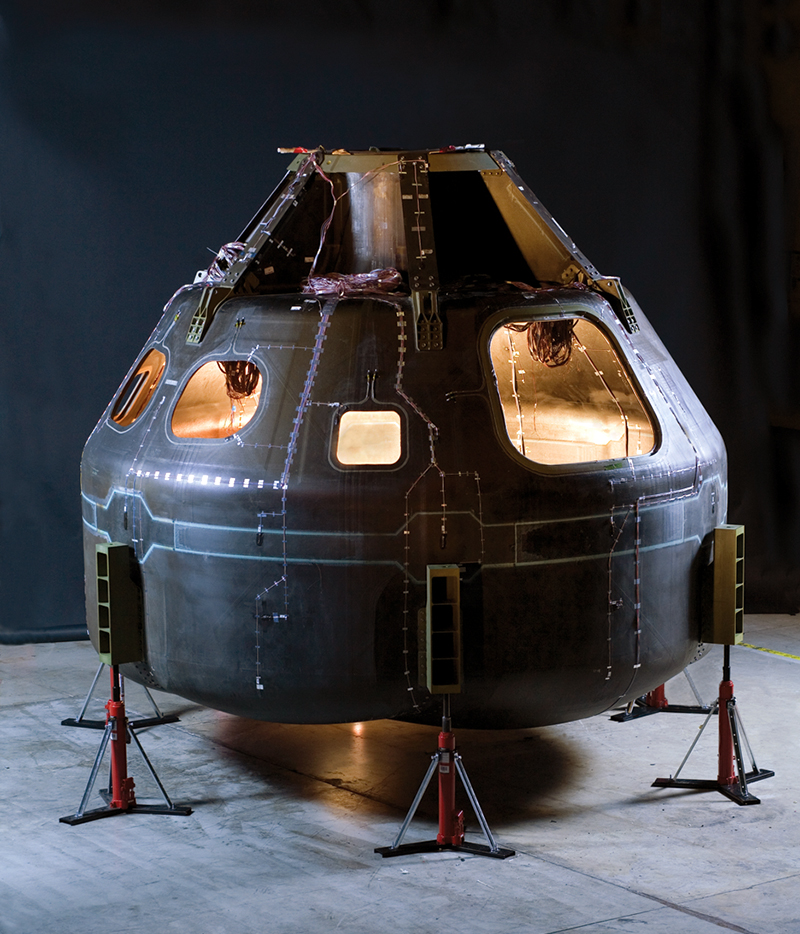
Smart Sensors Assess Structural Health
Originating Technology/NASA Contribution
The materials used to make airplanes and space shuttles do not last forever. That is why NASA frequently inspects launch vehicles, fuel tanks, crew habitats, and other components for structural damage. The timely and accurate detection of cracks or other damage can prevent failure, prolong service life, and ensure safety and reliability.
To perform quick, nondestructive evaluation and monitoring of aerospace vehicles and structures, NASA pursues the development of structural health monitoring (SHM) systems. SHM aims to build a system with a network of sensors placed in critical areas where structural integrity must be maintained, such as vehicle stage sections, separation interfaces, solid motors, and tanks. The sensors send information to a computer that is programmed to recognize patterns of electrical signals that represent damage, such as strains, breaks, or cracks. These systems can automatically collect and process data.
One approach to SHM is the Stanford Multi-Actuator Receiver Transduction (SMART) Layer, a patented technology from Stanford University. The thin material layer is embedded with a network of piezoelectric sensors and actuators that can be mounted on metal structures or embedded in composite structures. The piezoelectric sensors give off a small amount of electricity when they undergo mechanical pressure. Similar to a medical ultrasound, the sensors generate a wave that propagates through the structure and is picked up by other sensors. The aim is not only to detect structural damage, but to provide early warning before a failure takes place.
To enhance and commercialize the SMART Layer, Acellent Technologies Inc. was founded in 1999 in Sunnyvale, California. Soon after its founding, the company created an SHM system consisting of the SMART Layer, supporting diagnostic hardware, and data processing and analysis software.
Partnership
In 2001, Acellent started working with Marshall Space Flight Center through a Small Business Innovation Research (SBIR) award to develop a hybrid SMART Layer for aerospace vehicles and structures. The hybrid layer utilized piezoelectric actuators and fiber optic sensors. As a result of the SBIR, the company expanded the technology’s capability to utilize a combination of sensors for various applications, such as monitoring strain and moisture.
A development known as the hybrid piezoelectric/fiber optic structural diagnostics system was intended to perform quick nondestructive evaluation and longer-term health monitoring of aerospace vehicles and structures, and could potentially monitor material processing, detect structural defects, detect corrosions, characterize load environments, and predict life. Piezoelectric actuators were embedded along with fiber optic detection sensors including Fabry-Perot fiber optic strain gauge sensors and fiber Bragg grating sensors.
Additional SBIRs with Marshall helped Acellent to improve and optimize its technology. The SMART Suitcase was developed and used for testing the SMART Layer and other SHM technologies. A NASA Space Act Agreement through Marshall investigated radio frequency attenuation transmission and detection using the SMART Layer approach. Marshall also provided knowledge advancement through testing opportunities with composite over-wrapped pressure vessels, which were being developed and studied for potential use in several space programs. Under a 2004 SBIR, Acellent tested and evaluated the performance of a SMART Tape, based on the SMART Layer, in harsh cryogenic conditions.
“We used the same base technology in all of the SBIRs, but for different applications requiring new innovations. This increased the reliability of the system and made it more robust,” says Shawn Beard, chief technology officer at Acellent.
In 2009, Acellent’s SMART Layer technology won the “Best Practical SHM Solution in Aerospace” award at the International Workshop on Structural Health Monitoring, sponsored by the Airbus Company. Twelve organizations participated in the competition, which was judged by representatives from industry, universities, and government agencies.
Beard attributes the technology’s competitive advantage to the knowledge gained while working with Marshall. “There are other technologies that are being applied for SHM, but they are behind in development of a complete system. There was a lot of testing and improving the technology over the last decade under the SBIR program to optimize the system,” says Beard.
In 2009 and 2010, Marshall supported the implementation and testing of the Acellent pitch-catch piezoelectric sensor on the Composite Crew Module (CCM) for the Ares Program. The CCM is a full-scale test version of the Orion spacecraft.
Product Outcome
Acellent develops advanced active and passive diagnostic systems using built-in networks of actuators and sensors.
Customarily, SHM uses sensors and actuators arrayed at various locations on a structure. In contrast, the SMART Layer contains an entire sensor and actuator array, making it unnecessary to install each sensor and actuator individually. The SMART Layer is pre-networked and pre-positioned, making it very easy for installation. The layer can be mounted on an existing structure or integrated into a composite structure during fabrication. Different types of sensors, such as piezoelectric and fiber optic, can both be embedded in the sheet to form a hybrid network.
Capable of being integrated into new or existing structures, SMART Layer technology is used to automate inspection and maintenance including structural condition monitoring, load and strain monitoring, impact detection, damage detection, impact damage assessment, crack growth monitoring, debonding detection, process monitoring, materials cure monitoring, and quality control.
The main benefits of SMART Layer technology are its flexibility, light weight, ability to adapt to any structure, ease of installation, durability, and reliability under different environments. The size and shape of the technology varies, and Acellent manufactures SMART Layers in numerous sizes, shapes, and complexities—from single sensor flat strip to multisensor 3-D shells. In addition to the sensor network, Acellent provides the diagnostic hardware and data analysis software for different SHM applications from monitoring large composite structures to localized damage detection in composites and metals.
According to Acellent, customers and partners include aerospace and automotive companies; construction, energy, and utility companies; and the defense, space, transportation, and energy industries. Private and government research labs have purchased the technology to gauge its performance in particular environmental conditions.
Acellent has had sales contracts with many major aerospace companies, including Boeing, Lockheed-Martin, Bombardier, and Airbus. Acellent is also customizing the technology for the U.S. Army to monitor fatigue cracks in rotorcraft structures. Recently, BMW used the SMART Layer technology on a concept vehicle to help verify the design and modeling, and to improve manufacturing techniques.
Over the last couple of years, Acellent has been funded to monitor civil infrastructure such as pipelines, buildings, and bridges, including a recent project with the National Institute of Standards and Technology. “We have been asked to develop a system—not just to monitor damage to a structure—but to monitor the overall framework or architecture for monitoring bridges across the Nation,” says Beard.
In addition to winning sales for research and testing, the company has won additional NASA SBIRs to apply the technology to large scale structures like rocket motors. Acellent’s long-term goal, however, is to have the technology become part of the design process. Instead of applying SHM after a new spacecraft is designed, Beard says the company envisions SHM being included in the original design of the structure. “If you design sensors into the structure in the beginning, you can optimize the structural design and reduce the overall weight of the vehicle. That is the direction we would like to see the technology go.”
SMART Layer® is a registered trademark of Acellent Technologies Inc.
SMART Suitcase™ is a trademark of Acellent Technologies Inc.

Acellent’s SMART Layers can be customized with two or more sensors in a strip unit, like the eight-sensor strips shown here, to monitor structural health conditions such as strain and moisture.

The Composite Crew Module (CCM) is a full-scale test version of the Orion spacecraft. As seen here, the CCM has fiber optic and traditional strain gauges attached.













